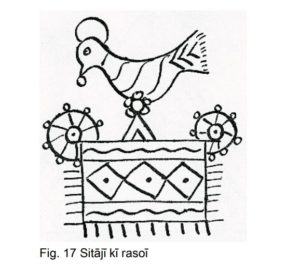भारतीय गिरमिटिया मजदूरों और उनके वंशजों की महिला लोक में गोदना या गोदना परंपरा बहुत प्रमुख थी। आज तक, 80 के दशक में महिलाएं अभी भी अपने अग्र-भुजाओं के लचीले पहलुओं पर ये टैटू गुदवाती हैं, एक तो उन्हें शादी से पहले मिला था और दूसरा शादी के बाद। वे सभी इस तथ्य पर ध्यान देते हैं कि यदि उनके पास ये नहीं थे, तो उनके ससुराल वाले या कोई पवित्र व्यक्ति भी उनसे जल ग्रहण नहीं करेगा। ये महिलाएं गोडना वलसा या गोडैया (टैटू कलाकार) के बारे में बताती हैं, जो अपने उपकरणों के साथ आते हैं, और गाते समय, वे टैटू को अग्र-भुजाओं, छाती, नाक और ठुड्डी पर अंकित करेंगे। सबसे लोकप्रिय डिजाइनों में से दो ke राम के बागैचा ’(राम का बगीचा) और ke सीता के रसोई’ (सीता की रसोई) थे। बाद का वर्णन नीचे दिया गया है। यह परंपरा अब कैरिबियन में मौजूद नहीं है और इसे केवल उन महिलाओं द्वारा याद किए जाने या याद करने के लिए कहा जाता है जो अभी भी जीवित हैं जो उन्हें सहन करती हैं।
The Godna or tattoo tradition was very prominent among the woman folk of the Indian indentured labourers and their descendants. Till today, women in their 80s still bear these tattoos on the flexor aspects of their forearms, one they got before marriage and the other after marriage. They all attest to the fact that if they did not have these, their in-laws or a holy man would not even accept water from them. These women tell of the Godna walas or Godaiyas (tattoo artists) who’d come with their instruments, and while singing, they would etch the tattoo on the forearm, chest, nose, and chin. Two of the most popular designs were ‘Ram ke bagaicha’ (the garden of Ram) and ‘Sita ke rasoi’ (Sita’s kitchen). The latter is illustrated below. This tradition no longer exists in the Caribbean and is only told in recollections or recounts by the women who are still alive that bear them.



Leave a Reply
You must be logged in to post a comment.